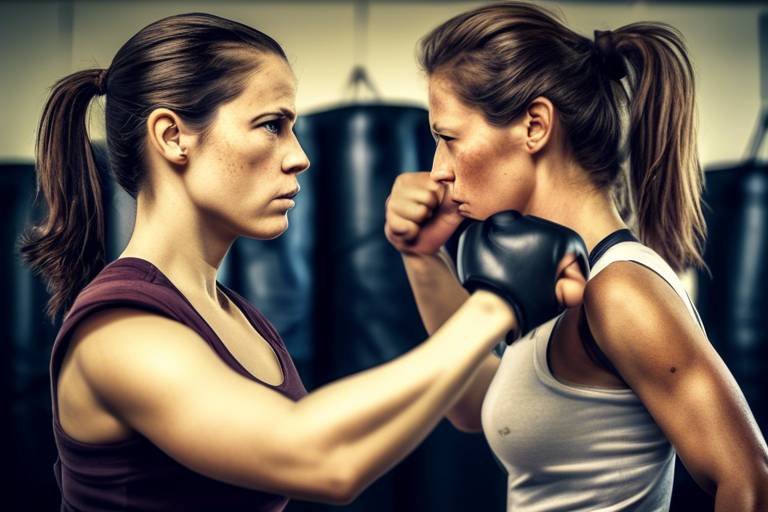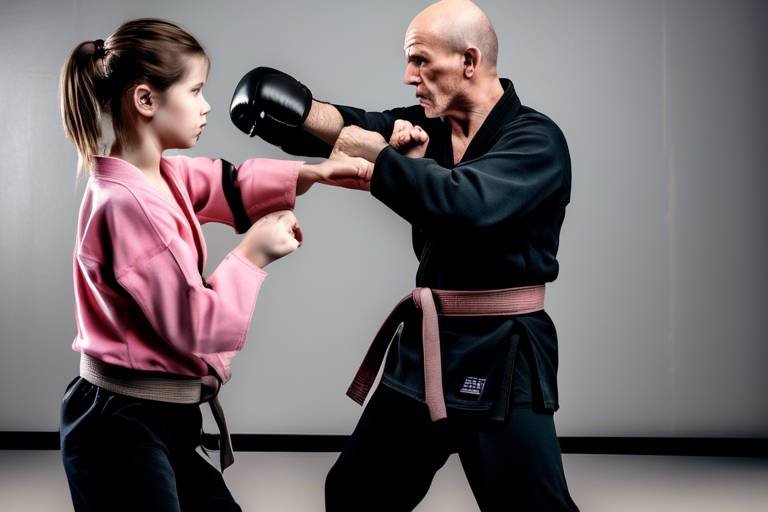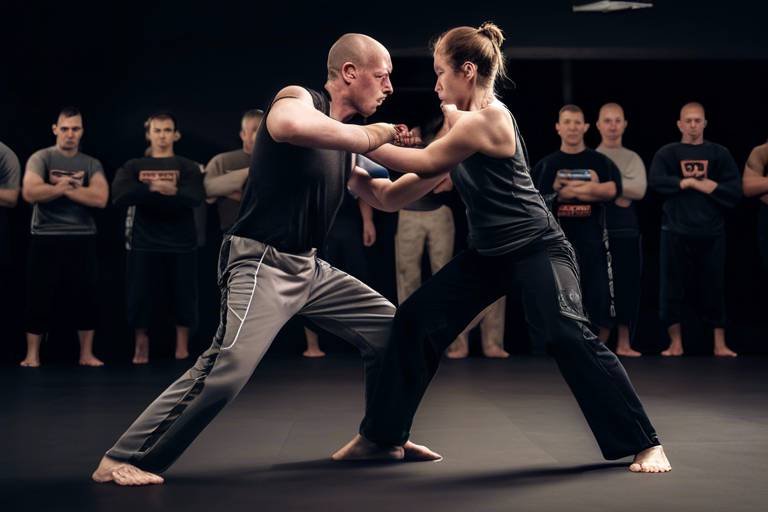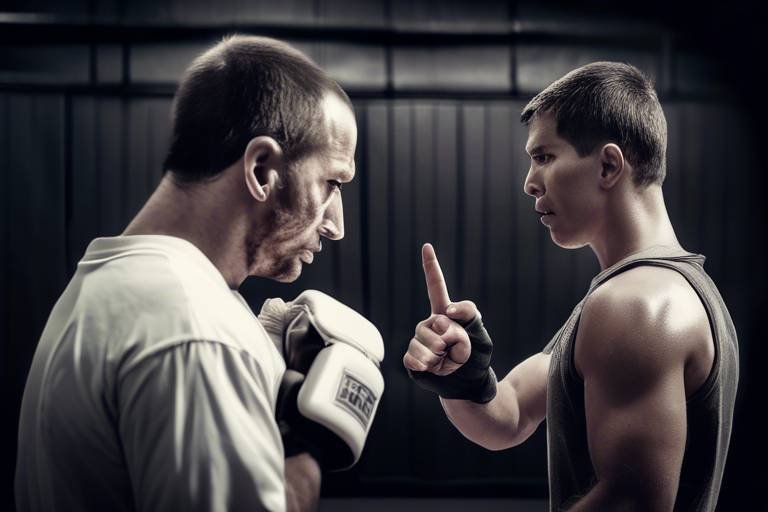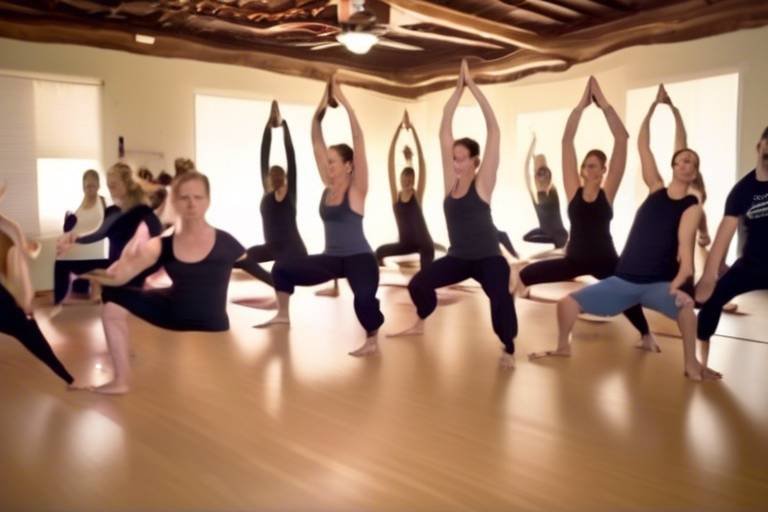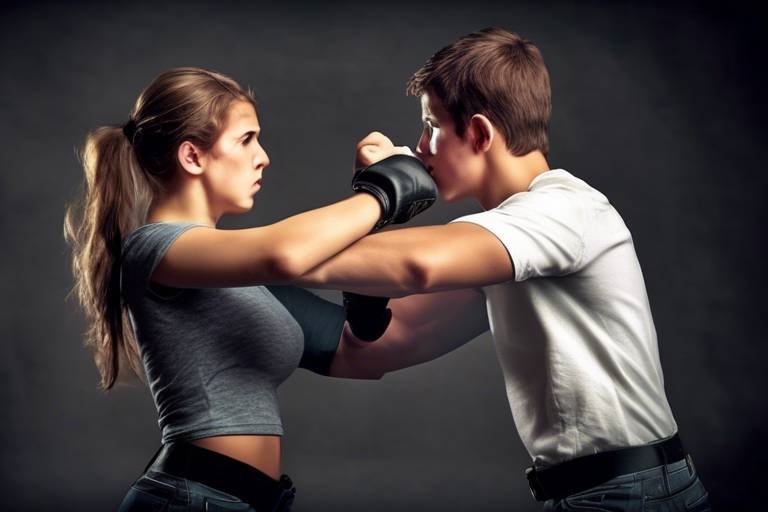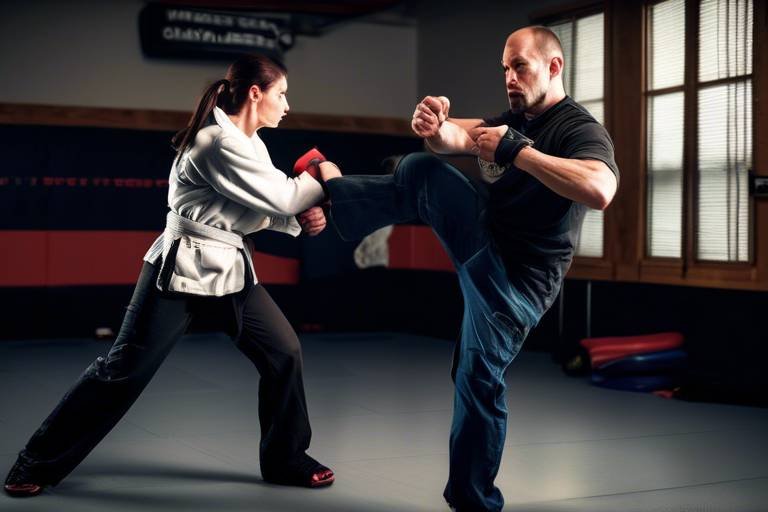The Impact of Gender on Self-Defense Techniques and Training
This article explores how gender influences self-defense strategies, training methods, and effectiveness. It aims to highlight the unique challenges and advantages faced by different genders in self-defense scenarios. Understanding these dynamics is not merely an academic exercise; it has profound implications for personal safety and empowerment in a world where threats can arise unexpectedly. Whether you’re a seasoned martial artist or someone just starting to think about self-defense, recognizing the impact of gender can enhance your training and preparedness.
When we talk about self-defense, we must first acknowledge the inherent physical and psychological differences between genders. For instance, men typically have greater upper body strength, which can influence the types of techniques that are most effective for them. Women, on the other hand, often excel in agility and flexibility, allowing them to evade attacks more effectively. But it’s not just about physicality; the perception of threat can also differ significantly. Men might approach a confrontation with a more aggressive mindset, while women may be more attuned to their surroundings, recognizing subtle cues that indicate danger.
Socialization plays a pivotal role in shaping how individuals approach self-defense. From a young age, societal norms and expectations can dictate what is considered appropriate behavior for different genders. For instance, boys are often encouraged to be assertive and confrontational, while girls may be taught to be more passive and accommodating. This disparity can lead to significant differences in confidence levels when it comes to personal safety. Women and marginalized genders might feel less empowered to engage in self-defense training, believing it’s not a skill set they are meant to possess.
Cultural beliefs about gender roles can dictate the perception of self-defense effectiveness. In some cultures, the notion of a woman defending herself might be frowned upon, leading to varying levels of participation in self-defense training. This can create a cycle where individuals feel less inclined to learn necessary skills, further perpetuating the idea that self-defense is not for everyone. It’s crucial to challenge these norms and encourage a culture where everyone feels empowered to learn self-defense, regardless of gender.
Gender stereotypes can hinder individuals from pursuing self-defense training. For example, women might feel that they are not strong enough to learn effective techniques, while men might believe they should not show vulnerability by seeking help. These stereotypes can lead to missed opportunities for personal growth and safety. It’s essential to break down these barriers and create a supportive environment where all individuals can thrive.
Creating inclusive self-defense training environments is vital. Programs should cater to diverse gender identities and promote equal participation. This means not only addressing the physical aspects of self-defense but also fostering a sense of community and support among participants. By encouraging inclusivity, we can empower individuals to take charge of their safety and well-being.
When it comes to self-defense techniques, there is a need for adaptability based on gender differences. For instance, techniques that rely heavily on brute strength may not be as effective for women, who might benefit more from techniques that emphasize leverage and agility. This variability necessitates a tailored approach to training, ensuring that all individuals can learn methods that suit their physical capabilities.
Psychological factors, such as fear and confidence, also play a significant role in self-defense effectiveness. Research shows that women often experience higher levels of anxiety in threatening situations, which can hinder their ability to respond effectively. Conversely, men may feel a heightened sense of confidence, which can sometimes lead to overestimating their abilities. Understanding these psychological dynamics is crucial for developing effective training programs that address the specific needs of different genders.
Confidence-building is a critical component of self-defense training, especially for women and marginalized genders. Training should focus not only on physical techniques but also on fostering a mindset of empowerment. When individuals feel confident in their abilities, they are more likely to respond effectively in threatening situations. Techniques such as visualization and scenario-based training can help build this confidence, making participants feel more prepared and capable.
Common psychological barriers, such as fear of failure or embarrassment, can prevent individuals from engaging in self-defense training. However, by creating a supportive and understanding training environment, these challenges can be addressed. Encouraging participants to share their experiences and fears can foster a sense of community and empowerment, ultimately leading to a more successful training experience.
Examining real-world case studies can illustrate the profound impact of gender on self-defense situations. For instance, a study might reveal that women who have undergone self-defense training are significantly more likely to successfully fend off an attacker compared to those who have not. Similarly, analyzing cases where individuals failed to defend themselves can provide insight into the challenges posed by societal norms and psychological barriers. These case studies can serve as powerful motivators for individuals to pursue self-defense training.
- What are the best self-defense techniques for women?
Techniques that emphasize leverage, agility, and situational awareness are often most effective for women. - How can I build confidence in self-defense?
Participating in training that focuses on practical scenarios and positive reinforcement can help build confidence. - Are self-defense classes inclusive of all genders?
Many modern self-defense programs strive to be inclusive, offering training that caters to diverse gender identities. - What role does socialization play in self-defense?
Socialization influences how individuals perceive their ability to defend themselves based on societal norms and expectations.

Understanding Gender Differences in Self-Defense
When we talk about self-defense, it's crucial to recognize that gender plays a significant role in shaping how individuals approach their personal safety. The inherent physical and psychological differences between genders can greatly affect the effectiveness of various self-defense techniques. For instance, men generally possess greater upper body strength compared to women, which can influence the types of techniques they might find more effective. However, this doesn't mean that women can't excel in self-defense; in fact, many techniques are based on agility and leverage rather than sheer strength.
Moreover, the perception of threat can vary widely between genders. Studies have shown that women often assess situations differently than men, sometimes viewing potential threats through a more nuanced lens. This difference in perception can lead to a greater awareness of their surroundings, which is a critical component of self-defense. Women, for example, might be more attuned to subtle social cues that indicate danger, making them adept at avoiding confrontations before they escalate.
It's also important to consider how training methods can be tailored to accommodate these differences. Self-defense training should not be a one-size-fits-all approach. Instead, it should take into account the unique strengths and weaknesses of each gender. For example, techniques that emphasize speed and agility may be more beneficial for women, while those focusing on strength may be more suited for men. This adaptability in training techniques can empower individuals, regardless of gender, to feel more confident in their ability to defend themselves.
In addition to physical differences, psychological factors also come into play. Confidence levels can fluctuate based on gender, with societal expectations often impacting how individuals perceive their capabilities in self-defense scenarios. For instance, women may feel less confident due to societal norms that discourage them from being assertive or aggressive. Addressing these psychological barriers is essential for effective self-defense training.
| Aspect | Men | Women |
|---|---|---|
| Physical Strength | Generally higher upper body strength | Often rely on agility and leverage |
| Perception of Threat | May focus on direct confrontations | More attuned to subtle social cues |
| Confidence Levels | Often encouraged to be assertive | May struggle due to societal norms |
Ultimately, understanding these gender differences in self-defense can lead to more effective training programs that cater to the specific needs of all individuals. By acknowledging and addressing these differences, we can create a more inclusive environment that empowers everyone to take charge of their personal safety.

The Role of Socialization in Self-Defense Skills
Socialization plays a pivotal role in shaping how individuals perceive and engage with self-defense skills. From a young age, societal norms and expectations influence our understanding of personal safety and the methods we believe are effective. For instance, boys are often encouraged to be assertive and aggressive, while girls may be socialized to be more passive or nurturing, which can lead to significant differences in how they approach self-defense training. This disparity can create a gap in confidence levels and the willingness to engage in self-defense practices.
Moreover, the environment in which a person is raised can deeply impact their perception of threat and their response to it. Children who grow up in households where discussions about personal safety and self-defense are common tend to have a better understanding of their own vulnerabilities and the skills needed to protect themselves. In contrast, those who are not exposed to such conversations may find themselves unprepared when faced with a threatening situation.
Consider this: if a young girl is taught that it’s not ladylike to fight back, she may internalize the belief that self-defense is not for her. On the other hand, a boy who is encouraged to stand up for himself might feel more empowered to take self-defense classes. This social conditioning can lead to a cycle where certain genders feel more entitled or capable of defending themselves, while others may feel discouraged.
Cultural beliefs about gender roles also dictate perceptions of self-defense effectiveness. In some cultures, men are expected to be protectors, while women are often seen as the ones needing protection. This can lead to varying levels of participation in self-defense training across genders. For instance, in cultures where masculinity is equated with physical prowess, men may dominate self-defense classes, while women might feel out of place or discouraged from participating.
Furthermore, the media often perpetuates stereotypes about gender and violence, showing men as the heroes and women as the victims. This portrayal can create a psychological barrier for women, making them believe that they are less capable of defending themselves. As a result, they might shy away from training, reinforcing the cycle of vulnerability.
Gender stereotypes can significantly hinder individuals from pursuing self-defense training. Many women might feel that self-defense is too aggressive or that they won’t fit in with a predominantly male group. This can lead to a lack of diversity in training environments, where women and marginalized genders feel isolated or unwelcome. Such stereotypes not only affect participation rates but also the effectiveness of the training itself, as a diverse group can bring a variety of perspectives and techniques to the table.
To combat these issues, it’s essential to create inclusive self-defense training environments that cater to diverse gender identities. Programs should actively promote equal participation and empowerment, ensuring that everyone, regardless of gender, feels welcome and capable of learning. This can involve using language that is neutral and encouraging, as well as showcasing a variety of instructors who represent different genders and backgrounds. By fostering an inclusive atmosphere, we can help break down the barriers that have historically kept certain groups from participating in self-defense training.
In summary, socialization has a profound impact on self-defense skills. By understanding the role that societal norms, cultural beliefs, and gender stereotypes play, we can work towards creating a more equitable landscape for self-defense training. This not only empowers individuals but also enhances overall community safety.
- How does socialization affect self-defense skills?
Socialization shapes perceptions of personal safety and influences confidence levels in engaging with self-defense training, leading to different outcomes based on gender. - What role do cultural norms play in self-defense training?
Cultural norms dictate the expectations of gender roles, which can affect participation rates and the effectiveness of training for different genders. - How can inclusivity be encouraged in self-defense training?
Creating a welcoming environment with diverse instructors and neutral language can help promote equal participation across gender identities.

Impact of Cultural Norms
The influence of cultural norms on self-defense is profound and multifaceted. These norms shape our beliefs about gender roles, expectations, and behaviors, which in turn affect how individuals approach self-defense training and techniques. For instance, in many cultures, traditional gender roles dictate that men are expected to be the protectors, while women are often viewed as needing protection. This can lead to a disparity in participation rates in self-defense classes, with men more likely to engage in aggressive training while women may feel discouraged or even intimidated.
Moreover, cultural beliefs can affect the perceived effectiveness of self-defense techniques. In societies where physical strength is highly valued, individuals may assume that self-defense is only effective for those who are strong or muscular. This misconception can deter many from pursuing self-defense training, particularly among women and those who do not fit the traditional mold of a 'fighter.'
To illustrate this point, consider the following table that outlines various cultural attitudes towards self-defense across different regions:
| Region | Cultural Attitude | Impact on Self-Defense Training |
|---|---|---|
| North America | Individualism; emphasis on personal empowerment | Higher participation in self-defense classes among all genders |
| Middle East | Traditional gender roles; emphasis on protection | Lower participation rates for women |
| East Asia | Collectivism; focus on harmony and avoidance of conflict | Less emphasis on physical self-defense training |
| Western Europe | Gender equality; strong advocacy for women’s rights | Increasing number of women participating in self-defense programs |
These cultural attitudes can create barriers for individuals seeking to learn self-defense. For example, women may feel that they are not entitled to defend themselves, or they may worry about being perceived as aggressive if they take the initiative in a self-defense situation. Such fears can lead to a reluctance to engage in training or to practice techniques that could be essential in a real-life scenario.
Furthermore, the normalization of violence in some cultures can also skew perceptions of self-defense. In environments where aggression is commonplace, individuals may feel that their self-defense options are limited to physical confrontation, which can be both frightening and impractical. This highlights the need for a broader understanding of self-defense that includes verbal de-escalation techniques and situational awareness, which can empower individuals of all genders to feel more confident in their ability to protect themselves.
In conclusion, cultural norms play a significant role in shaping self-defense training and perceptions. By challenging these norms and promoting more inclusive and empowering self-defense strategies, we can create a society where everyone feels capable and confident in their ability to defend themselves, regardless of gender.

Gender Stereotypes in Training
Gender stereotypes can act as invisible barriers in the realm of self-defense training, shaping not only who participates but also how they engage with the techniques being taught. For instance, the stereotype that men are naturally stronger and more capable of defending themselves can lead to the assumption that women are less competent in physical confrontations. This perception can discourage women from even considering self-defense training, as they may internalize the belief that it's not meant for them. Conversely, men may feel pressured to conform to traditional notions of masculinity, believing they must be aggressive or overly dominant in their approach to self-defense.
These stereotypes can manifest in training environments, where instructors might unintentionally favor techniques that align more closely with male participants’ physicality, neglecting the unique needs of female or non-binary trainees. The result? A training atmosphere that feels exclusive and unwelcoming to those who do not fit the traditional mold. This can lead to a lack of confidence among women and other marginalized genders, who may feel their physical capabilities are being underestimated or overlooked.
Moreover, the impact of these stereotypes extends beyond the training room. In real-world scenarios, individuals who have internalized these beliefs may hesitate to act in self-defense situations, doubting their skills and instincts. It’s crucial for training programs to confront these stereotypes head-on, creating an environment that not only acknowledges but actively works to dismantle these harmful beliefs. By fostering an inclusive atmosphere, we can empower all individuals to feel capable and confident in their self-defense abilities.
To combat these stereotypes effectively, training programs should incorporate a diverse range of teaching methods and techniques that cater to various body types and skill levels. This might include:
- Offering tailored techniques that focus on leverage and agility rather than sheer strength.
- Encouraging cooperative learning, where participants of all genders can practice together, fostering support rather than competition.
- Highlighting success stories from individuals of various genders who have effectively used self-defense techniques in real-life situations.
In this way, self-defense training can become a powerful tool for empowerment, breaking down the barriers created by gender stereotypes and allowing everyone to reclaim their personal safety.
- What are some common gender stereotypes in self-defense training? Gender stereotypes often suggest that men are inherently stronger and more capable of defending themselves, while women are seen as less capable or more vulnerable.
- How can training programs promote inclusivity? By offering diverse techniques that cater to various physical abilities, fostering a supportive environment, and challenging traditional gender norms.
- What impact do these stereotypes have on real-world self-defense situations? Individuals who internalize these stereotypes may lack the confidence to act in self-defense situations, potentially jeopardizing their safety.

Encouraging Inclusivity in Training Programs
In today's world, the importance of inclusivity in self-defense training programs cannot be overstated. As we strive to create environments where everyone feels empowered to learn and defend themselves, it’s crucial to recognize that self-defense is not a one-size-fits-all approach. Inclusivity means understanding and accommodating the diverse needs of individuals across the gender spectrum. This includes not only physical differences but also varying levels of confidence and experience.
Training programs should be designed with an awareness of these differences, ensuring that all participants can engage fully and benefit from the training. For instance, instructors should be trained to recognize and address the unique challenges faced by individuals of different genders. This could mean adapting techniques to suit various physical capabilities or providing additional support to those who may feel intimidated in a mixed-gender setting. It’s about creating a space where everyone feels safe and valued.
Moreover, inclusivity in self-defense training can significantly enhance the overall effectiveness of the program. When individuals feel comfortable and respected, they are more likely to engage actively in the training process. This can lead to better retention of techniques and a greater sense of empowerment. To foster this environment, training programs should:
- Incorporate diverse teaching styles that resonate with different learning preferences.
- Encourage open discussions about personal experiences and fears related to self-defense.
- Provide opportunities for peer support and mentorship among participants.
By implementing these strategies, we can not only enhance the learning experience but also promote a culture of mutual respect and understanding. This is particularly important in self-defense training, where the psychological aspect of feeling secure can be just as vital as mastering physical techniques.
Ultimately, the goal is to create self-defense programs that are not only effective but also empowering. When individuals of all genders see themselves represented and supported in training environments, they are more likely to take ownership of their safety and well-being. This shift towards inclusivity is not just beneficial for participants; it enriches the entire community by fostering a sense of solidarity and shared purpose.
As we move forward, let’s remember that the fight for inclusivity in self-defense training is a collective effort. It requires commitment from instructors, participants, and the broader community to ensure that everyone has access to the skills and confidence needed to defend themselves. By working together, we can create a world where self-defense is not only a skill but also a fundamental right for all.

Physical Techniques: Variability Across Genders
When it comes to self-defense, the physical techniques employed can vary significantly across genders. This variability stems from a combination of biological factors and social conditioning, which together shape how individuals approach self-defense. For instance, men typically possess greater upper body strength and muscle mass, which can influence the effectiveness of certain striking techniques. Women, on the other hand, may excel in agility and flexibility, allowing them to utilize techniques that involve quick movements and evasive actions.
One of the most crucial aspects of adapting self-defense techniques is recognizing that not every person fits into a traditional mold based on their gender. While generalizations can be made, it is essential to tailor training to the individual’s unique strengths and weaknesses. For example, a woman might find that techniques such as joint locks and throws are more effective for her, as these moves can capitalize on an opponent's momentum rather than relying solely on brute strength.
Moreover, the approach to self-defense can also be influenced by the psychological mindset associated with gender. Studies have shown that women often face different emotional responses in threatening situations, such as heightened fear or anxiety. This can affect their ability to execute techniques effectively. Therefore, training that emphasizes not just the physical aspects, but also the mental preparation, can be incredibly beneficial. This dual approach helps individuals, regardless of gender, to respond more confidently and effectively in real-life situations.
Additionally, the effectiveness of self-defense techniques can be enhanced by understanding the dynamics of an encounter. For instance, when faced with an aggressor, it’s essential to assess the situation quickly. Here, techniques that prioritize de-escalation and escape might be more appropriate than engaging in physical confrontation. This is where training programs should emphasize situational awareness, teaching individuals to recognize potential threats and respond accordingly.
To illustrate the diversity in self-defense techniques, consider the following table that summarizes various techniques and their applicability based on gender-specific strengths:
| Technique | Gender Strength | Effectiveness |
|---|---|---|
| Joint Locks | Women (Agility) | High |
| Striking Techniques | Men (Strength) | High |
| Evasive Maneuvers | Women (Flexibility) | Moderate to High |
| Ground Defense | Men & Women (Varied) | Variable |
In conclusion, the variability in physical techniques across genders highlights the need for personalized self-defense training. By recognizing and embracing these differences, training programs can equip individuals with the skills they need to defend themselves effectively. Ultimately, the goal is to empower everyone, regardless of gender, to feel confident and capable in their ability to protect themselves.
- How can self-defense techniques be adapted for different genders? Self-defense techniques can be tailored by focusing on individual strengths, such as agility or strength, and incorporating psychological training to enhance confidence.
- What role does social conditioning play in self-defense? Social conditioning influences how individuals perceive threats and their responses, often leading to different approaches in self-defense based on gender.
- Are there specific self-defense techniques recommended for women? Techniques that emphasize joint locks and evasive maneuvers are often recommended for women, as they leverage agility and can be effective against larger aggressors.

Psychological Factors in Self-Defense
The realm of self-defense is not solely about physical prowess; it is equally influenced by psychological factors that can significantly impact an individual's ability to respond effectively in threatening situations. Understanding how fear, confidence, and mindset play a role in self-defense can be the difference between a successful defense and a missed opportunity. This is particularly true when we consider the diverse experiences of individuals across different genders.
One of the most notable psychological factors in self-defense is fear. Fear can be a double-edged sword; while it can heighten awareness and prepare the body for action, it can also lead to paralysis in critical moments. For many, especially women and marginalized genders, the fear of violence can be overwhelming, often stemming from societal narratives that emphasize vulnerability. This fear can manifest in various ways, causing individuals to avoid self-defense training altogether or to approach it with trepidation. It’s essential to address these fears head-on in training environments to help individuals build resilience and confidence.
Confidence, on the other hand, is a crucial psychological component that can significantly enhance one’s ability to defend themselves. When individuals feel confident in their skills, they are more likely to react decisively when faced with a threat. This is particularly important for women, who may often feel less empowered in self-defense scenarios. Training programs that focus on building confidence through practical exercises, role-playing scenarios, and positive reinforcement can help individuals overcome their fears and embrace a proactive approach to personal safety.
Moreover, the concept of a growth mindset plays a pivotal role in self-defense training. Individuals who believe that their abilities can improve through dedication and hard work are more likely to persevere in the face of challenges. This mindset encourages participants to view setbacks as opportunities for growth rather than insurmountable obstacles. In self-defense training, fostering a growth mindset can lead to greater engagement and a willingness to learn from mistakes, ultimately enhancing one's self-defense capabilities.
To illustrate the psychological factors at play, consider the following table, which summarizes the key psychological elements that influence self-defense effectiveness:
| Psychological Factor | Impact on Self-Defense |
|---|---|
| Fear | Can lead to paralysis or avoidance of training; may heighten awareness. |
| Confidence | Increases likelihood of decisive action; fosters a proactive approach. |
| Growth Mindset | Encourages resilience and continuous improvement; enhances engagement in training. |
In addition to these factors, it is essential to recognize the impact of social support and community in self-defense training. Having a supportive network can bolster confidence and provide a safe space for individuals to practice their skills. When participants feel backed by their peers and instructors, they are more likely to push through their psychological barriers and engage fully in the training process. This sense of community can be particularly empowering for those who may feel isolated in their self-defense journey.
Ultimately, addressing the psychological aspects of self-defense is crucial for creating effective training programs. By focusing on fear management, confidence building, and fostering a growth mindset, instructors can equip individuals with the tools they need to respond effectively in real-life situations. The journey to self-defense mastery is as much about mental preparation as it is about physical technique, and recognizing this duality can lead to more empowered and capable individuals.
- What role does fear play in self-defense? Fear can either enhance awareness or lead to paralysis. It’s essential to address and manage fear in training.
- How can confidence be built in self-defense training? Confidence can be built through practical exercises, positive reinforcement, and role-playing scenarios.
- What is a growth mindset, and why is it important? A growth mindset encourages individuals to see challenges as opportunities for growth, enhancing their resilience and engagement in training.
- How does social support influence self-defense training? A supportive community can bolster confidence and provide a safe environment for practice, making training more effective.

Building Confidence Through Training
Building confidence through self-defense training is not just about learning to throw a punch or execute a perfect kick; it’s about empowering individuals to feel capable of handling threatening situations. For many, especially women and marginalized genders, the journey to self-confidence can be a transformative experience. When participants engage in self-defense classes, they often discover that the training goes beyond physical techniques—it fosters a sense of strength, resilience, and assertiveness.
The act of training itself can be a powerful confidence booster. As individuals practice various techniques, they begin to understand their own physical capabilities and limitations. This understanding is crucial because it allows them to develop a realistic self-assessment. For instance, a person who may initially feel weak or unsure of their ability to defend themselves can gradually learn to execute moves that surprise even themselves. This realization can be likened to the moment a child learns to ride a bike; the initial fear transforms into exhilaration as they gain balance and control.
Moreover, the environment in which self-defense training takes place plays a significant role in building confidence. Instructors who create a supportive and inclusive atmosphere encourage participants to push their boundaries without the fear of judgment. This sense of community can be incredibly uplifting. Imagine a room full of individuals, each at different levels of experience, all cheering each other on. It’s this atmosphere that fosters growth and confidence, making it clear that everyone is on their own journey.
Additionally, self-defense training often incorporates mental conditioning alongside physical techniques. Participants learn to recognize potential threats and how to respond effectively. This mental preparation is vital in building confidence because it shifts the focus from fear to empowerment. When someone knows they have the skills to assess a situation and respond accordingly, their confidence soars. They are no longer passive bystanders in their own lives; they become active participants in their safety.
To illustrate the impact of confidence-building through training, consider the following table that outlines common benefits experienced by individuals who engage in self-defense classes:
| Benefit | Description |
|---|---|
| Increased Physical Fitness | Regular training improves overall strength, agility, and endurance. |
| Enhanced Situational Awareness | Participants learn to identify and assess potential threats in their environment. |
| Improved Self-Esteem | Mastering new skills leads to a greater sense of self-worth and capability. |
| Community Support | Training often fosters friendships and support networks among participants. |
Ultimately, building confidence through self-defense training is a multifaceted process that combines physical skills with mental preparedness and emotional support. It’s about creating a space where individuals can learn, grow, and empower themselves to take control of their personal safety. As they progress through their training, they not only become more capable of defending themselves but also cultivate a lasting sense of confidence that permeates other areas of their lives.
- What age is appropriate to start self-defense training? Many self-defense programs cater to various age groups, so it's best to find a class that suits your age and skill level.
- Do I need to be physically fit to participate in self-defense training? No, self-defense training is designed for people of all fitness levels, and it often improves your fitness as you progress.
- How long does it take to become proficient in self-defense? Proficiency varies by individual, but consistent training over several months can lead to significant improvement.
- Is self-defense training only for women? No, self-defense training is beneficial for all genders and is designed to empower everyone.

Overcoming Psychological Barriers
When it comes to self-defense, understanding the psychological barriers that individuals face can be just as crucial as mastering physical techniques. Many people, regardless of gender, grapple with feelings of fear, anxiety, and self-doubt when thinking about defending themselves. These emotions can create significant roadblocks that hinder effective responses in threatening situations. For instance, a person might freeze in fear, allowing an opportunity for an attacker to gain the upper hand. But the good news is that these barriers can be overcome with the right mindset and training.
One effective strategy for overcoming psychological barriers is through exposure therapy. This involves gradually exposing individuals to self-defense scenarios in a controlled environment, allowing them to build confidence over time. Imagine learning to ride a bike; at first, it feels daunting, but with practice, you gain balance and control. Similarly, practicing self-defense techniques repeatedly can help individuals feel more prepared and less fearful. This method not only helps in desensitizing the fear response but also instills a sense of competence.
Moreover, mental visualization can be a powerful tool. By visualizing oneself successfully navigating a self-defense situation, individuals can condition their minds to respond more effectively when faced with real threats. This technique is akin to an athlete picturing their performance before a big game. It creates a mental blueprint, enhancing readiness and reducing anxiety. Incorporating visualization exercises into training can significantly boost participants' confidence levels, enabling them to approach self-defense with a more empowered mindset.
Another common barrier is the fear of judgment or ridicule, particularly among those who may feel out of place in traditional self-defense classes. To combat this, creating a supportive training environment is essential. Instructors should foster a culture of inclusivity and encouragement, where every participant feels valued and respected, regardless of their background or skill level. This sense of community can alleviate fears and motivate individuals to engage more fully in their training.
It's also important to address the pervasive issue of self-doubt. Many individuals question their ability to defend themselves, often comparing themselves unfavorably to others. Acknowledging these feelings is the first step. Instructors can help by encouraging participants to focus on their unique strengths and progress rather than comparing themselves to others. By setting personal goals and celebrating small victories, individuals can gradually build their self-esteem and resilience.
Finally, the role of peer support cannot be overstated. Engaging with others who share similar fears and aspirations can provide a sense of camaraderie and motivation. Group training sessions not only enhance learning but also create an environment where participants can share their experiences and strategies for overcoming psychological barriers. This mutual support can be incredibly empowering, reminding individuals that they are not alone in their journey.
In conclusion, overcoming psychological barriers in self-defense involves a combination of exposure, visualization, supportive environments, self-acceptance, and peer support. By addressing these challenges head-on, individuals can transform their fears into strengths, ultimately enhancing their ability to protect themselves in real-life situations.
- What are the common psychological barriers faced in self-defense?
Common barriers include fear, anxiety, self-doubt, and the fear of judgment. - How can exposure therapy help in self-defense training?
Exposure therapy allows individuals to gradually face their fears in a controlled environment, building confidence over time. - What role does visualization play in overcoming psychological barriers?
Mental visualization helps condition the mind to respond effectively to threats, enhancing readiness and reducing anxiety. - Why is a supportive training environment important?
A supportive environment fosters inclusivity and encourages individuals to engage fully, alleviating fears of judgment. - How can peer support enhance self-defense training?
Peer support creates a sense of camaraderie, motivating individuals to share experiences and strategies, making the training journey less isolating.

Case Studies: Gender and Self-Defense Outcomes
The exploration of self-defense outcomes through the lens of gender reveals a compelling narrative filled with both triumphs and challenges. To understand the impact of gender on self-defense, we can look at various case studies that highlight how different genders experience and respond to threatening situations. These real-world scenarios not only showcase the effectiveness of self-defense techniques but also underline the psychological and social factors that play a significant role in these encounters.
For instance, consider a case study involving a female college student who successfully defended herself against an attempted assault. She had undergone specialized self-defense training that focused on situational awareness and quick, effective responses. This training was crucial, as it not only equipped her with physical techniques but also instilled a sense of confidence that allowed her to react decisively when faced with danger. The success of her defense can be attributed to her preparedness and the specific techniques she learned, which were tailored to her physicality and the common threats faced by women.
In contrast, a male participant in a similar self-defense program reported feeling overconfident after training. He believed that the strength advantage he possessed would always ensure his safety. However, during a sparring exercise, he faced a smaller opponent who used agility and technique to outmaneuver him. This highlights a crucial aspect of gender in self-defense: the perception of strength can sometimes lead to complacency, which can be detrimental in real-life scenarios. The case underscores that self-defense is not solely about physical prowess; it also requires mental acuity and adaptability.
Moreover, a study conducted in a community center revealed that participants from diverse gender identities faced unique challenges in self-defense situations. Many reported feeling marginalized or underestimated due to societal stereotypes. In one notable instance, a transgender individual shared their experience of being targeted while walking home. They had previously taken self-defense classes that emphasized de-escalation techniques and personal safety awareness. Although they did not engage physically, their training allowed them to navigate the situation calmly, ultimately avoiding confrontation. This case exemplifies how tailored training can empower individuals, regardless of gender, to handle potentially dangerous situations effectively.
To further illustrate the impact of gender on self-defense outcomes, we can analyze the following table, which summarizes key findings from various case studies:
| Case Study | Gender | Outcome | Key Takeaway |
|---|---|---|---|
| College Student Assault | Female | Successfully defended herself | Confidence and training are crucial. |
| Sparring Exercise | Male | Overconfidence led to defeat | Strength alone is not enough; technique matters. |
| Community Center Incident | Transgender | Avoided confrontation | Empowerment through tailored training. |
These case studies highlight a significant point: self-defense is not a one-size-fits-all approach. Each gender, and indeed each individual, brings unique strengths and vulnerabilities to the table. The effectiveness of self-defense techniques often hinges on understanding these differences and adapting training accordingly.
As we continue to gather data and analyze outcomes from various self-defense scenarios, it becomes increasingly clear that gender plays a vital role in shaping experiences and responses. By fostering an inclusive training environment and encouraging individuals to engage with self-defense techniques that resonate with their identities, we can enhance the overall effectiveness and empowerment of self-defense practices across all genders.
- How does gender affect self-defense training?
Gender can influence the approach to training, the techniques taught, and the psychological preparedness of individuals, leading to varied outcomes in self-defense situations. - Are there specific self-defense techniques better suited for different genders?
Yes, some techniques may be more effective for different body types and physical capabilities, making it essential to tailor training to individual needs. - What role does confidence play in self-defense?
Confidence is crucial in self-defense, as it enables individuals to react effectively under pressure. Training that builds confidence can improve outcomes in threatening situations.
Frequently Asked Questions
- How does gender influence self-defense techniques?
Gender can significantly impact the choice and effectiveness of self-defense techniques. For instance, physical differences, such as strength and agility, may lead individuals to adopt different strategies. Women, for example, might benefit from techniques that leverage speed and evasion rather than pure strength, allowing them to navigate confrontations more effectively.
- What role does socialization play in self-defense training?
Socialization shapes how individuals perceive their ability to defend themselves. Societal norms often dictate what is considered appropriate behavior for different genders, affecting confidence levels and willingness to engage in self-defense training. This can result in some groups feeling more empowered and prepared than others.
- Are there specific psychological factors that differ by gender in self-defense?
Yes, psychological factors such as fear, confidence, and perception of threat can vary significantly across genders. For instance, women may experience heightened fear in threatening situations, which can hinder their response. Building confidence through training is essential, particularly for women and marginalized genders, to enhance their effectiveness in self-defense scenarios.
- How can cultural norms affect participation in self-defense training?
Cultural beliefs about gender roles can greatly influence participation in self-defense training. In some cultures, traditional views may discourage certain genders from engaging in physical training, leading to lower participation rates and a lack of skills that could be critical in self-defense situations.
- What are common psychological barriers to effective self-defense?
Common psychological barriers include fear of failure, self-doubt, and societal stigma. These factors can prevent individuals from taking self-defense training seriously or from effectively applying their skills in real-life situations. Overcoming these barriers is crucial for building a more empowered mindset.
- How can self-defense training be made more inclusive?
Creating inclusive self-defense training programs involves recognizing and addressing the diverse needs of participants. This can include adapting techniques to be accessible for various body types and ensuring that the training environment is supportive and free from stereotypes, allowing everyone to feel empowered to learn and defend themselves.
- What are some examples of successful self-defense outcomes based on gender?
Case studies show that individuals who receive tailored self-defense training often experience better outcomes in real-life situations. For example, women who learn techniques specifically designed for their physicality report feeling more confident and capable of defending themselves, leading to successful de-escalations in threatening scenarios.

